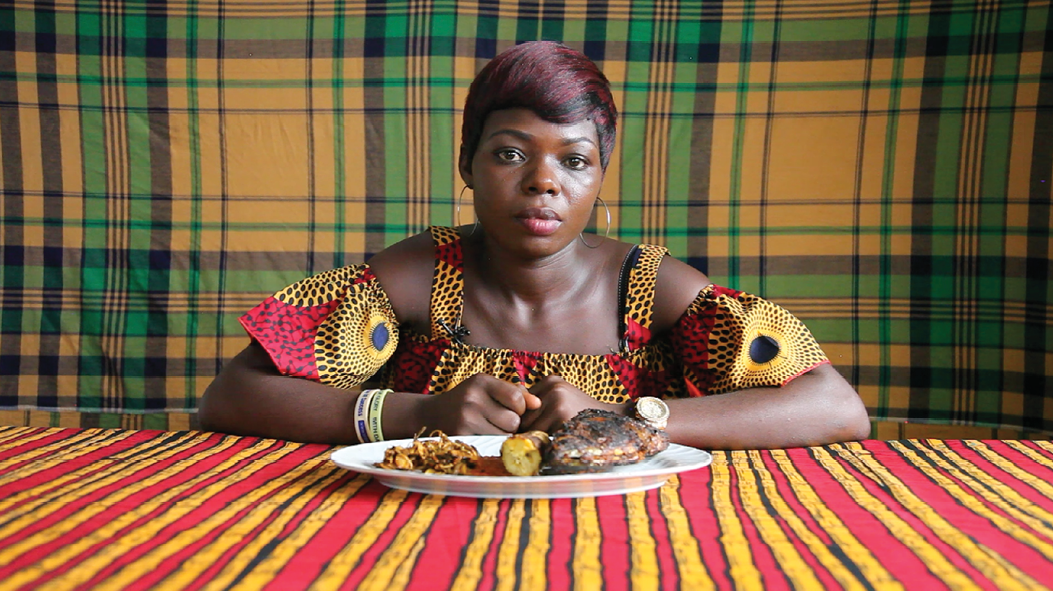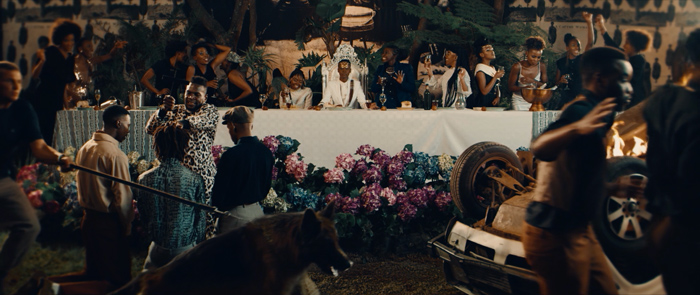Three immersive films from Africa about political and cultural resistance use tropes of the Imaginary from Fanon to Lacan to challenge inherited postcolonial mindsets.
Kudzanai Chiurai presents a gorgeous, disorienting series of seven tableaux dramatizing the agony of Zimbabwe as a young nation. Colonial capitalism, as much as religious fervor and sectarian violence play throughout the intensely stylized scenes. With a mesmerizing soundtrack directed by João Orecchia, We Live in Silence (2017) proceeds at perhaps five frames-per-second so that we linger on every eye-blink, laugh or bodily twist. With men given perfunctory roles in violent scenes as members of the Army, priesthood, militia or victims, the innate objectification of the camera on the female lead clearly collapses woman/nationhood, seemingly uncritically, especially regarding the display of her body. A nod to the important presence of women in the guerrilla movements of the early 1980s could partly salvage this reading (cf. the film Flame—1996, Ingrid Sinclair), but the final banquet, where (male) bodies are shot and beaten brings home the point: the national imaginary, theatricalized by the artist, is a national emergency.
Mikhael Subotzky’s 3-channel installation WYE (2016), viewed from reclining beach chairs on a floor of sand, lulls us with the sound of ocean waves into considering how a techno-surveillance state commands the Imaginary to meet the accords of post-apartheid society. Set in a past-present-future somewhere on the coast near Johannesburg, rotating films show an early European explorer’s treasure uncovered by a present-day Caucasian lighthouse keeper with the help of a scantily paid black laborer. We learn of the keeper’s future embodiment as a kind of Black Mirror-like virtual teaching aid after he willingly (?) submits to the “Body Emancipation Project,” which renders his confessional email exchange with a friend visible in all key strokes: but the fear of black faces in Jo-burg (“a powder keg”) is deleted; the “incident” that happened to a mutual friend—deleted, yet the black man who assisted him still “came out of nowhere,” leaving the suggestion that Africa will again be a place to dream about occupying, without bodies, as it was before history’s repercussions.
The strongest piece in the show is by filmmaker Zina Saro-Wiwa, daughter of author/activist Ken Saro-Wiwa, who actuates a “Decolonizing the Mind” by inviting viewers to share a meal with a chorus of faces in the Niger Delta. A dozen screens set upon individual tables display the visceral chewing of local dishes from start to finish. Like Instagram photos from eager foodies, high establishing shots of each plate cut to a person eating pumpkin leaf soup, roasted snails, pounded sweet potatoes or yard apples with spicy nut butter. The stoic expressions of finger-sucking locals (no utensils) resist becoming “spectacle” because Table Manners (2014–ongoing) is interrogating the viewer. Shell Oil production and global consumption has polluted Ogoniland, sickened people, and bred decades of violence (including Saro-Wiwa’s father’s execution). The tables are turned, and through the indelible, inscrutable images of the Ogoni faces before us engaged in a simple act of eating, we see their resolve to remain on a land shadowed by bloodshed in order to imagine its future.



